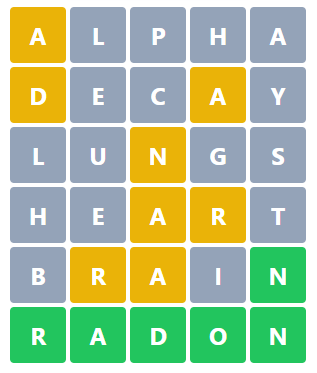
Two homes have identical 4pCi per liter (picocuries per liter) radon concentrations, indicating that 8.8 radon atoms are radioactively decaying every minute in every liter of the homes’ air. Do occupants in the two homes have the same exposure to radon’s harmful effects? If one of the homeowners is smart about managing their home’s air quality and the other is not, the answer is NO! Homes with identical radon concentrations can have significantly different levels of exposure to radon’s radioactive chain of decay events.
The Wordle above is nothing to brag about. Too many ineffective guesses. Radon, however, is something we can manage without guessing. The same tools we use for reducing airborne disease transmission, chemical toxicity, and particulate concentration in indoor environments allow us to manage radon: fresh air, air recirculation filtration, and source reduction. The cost of not taking control of radon’s effects is too great as a growing body of medical research continues to link radon to devasting impacts throughout our bodies.
There is more to radon than simply knowing its pCi per liter. Radon is linked to lung cancer and suspected to be a contributor to other cancers, dementia, ventricular arrhythmia, and other health problems. Incredibly, without ingesting or inhaling any lead over one’s lifetime, radon can move across the blood-brain barrier (BBB) into the brain, stranding its radioactive products (polonium, bismuth and lead) that are blocked by the BBB from leaving. Radon finally ends its more than two-decade journey as a stable but toxic deposit of lead (206Pb).
Our article discusses radon and its progeny, how they travel throughout our bodies, and what we can do to minimize radon in our indoor environments.
Introduction
Fresh air ventilation and air infiltration impact radon concentration level in homes in a similar manner as carbon dioxide. For example, a home with 4pCi per liter of radon and 1200ppm carbon dioxide (typical of today’s inadequate ASHRAE 62.1 and 62.2 odor-based ventilation standards) could reduce radon to 2pCi per liter by decreasing indoor carbon dioxide to Build Equinox’s recommended 800ppm level (approximately doubling ASHRAE ventilation). Smart ventilation achieves better air quality while using less energy than dumb, constant flow ventilation, as described by the folks at Lawrence Berkeley National Laboratory.
Current US EPA guidelines for radon is 4pCi/liter. Are all homes with 4pCi per liter the same? The short answer is no. Homes with non-recirculation, constant flow ventilation systems are exposing occupants to more tissue damaging radiation as homes with whole house air recirculation and filtration.
We designed the CERV (first gen) and our current CERV2 smart ventilation units with air recirculation filtration as an essential feature more than 12 years ago. Homes without air recirculation have higher particulate concentrations, higher airborne microbe concentrations, and in terms of radon, higher radioactive particulate concentrations.
A Bit About Radon
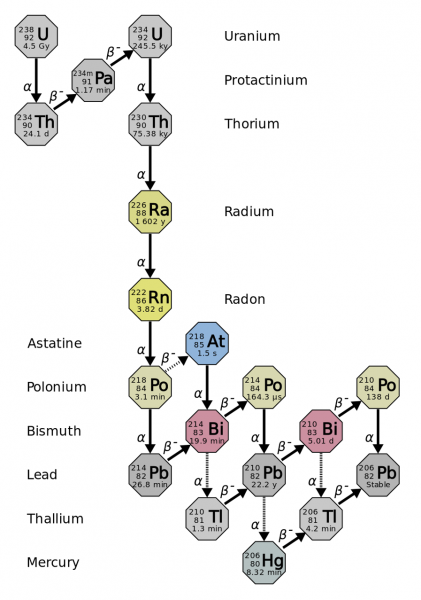
Radon takes an incredible journey to reach the inside of your home! Born in uranium rock more than 4 billion years old, radioactive decay transforms uranium into radium. Half of this radium undergoes another radioactive decay that transforms half of it into radon gas over another 1620 years. A high energy alpha particle (helium nucleus composed of two protons and two neutrons) is emitted from a radium atom as radon is created. Recoil of radon atoms from alpha particle emissions drives some of the newly formed radon gas out of the rock and into fissures and cracks, allowing radon to escape to the atmosphere. Unlike uranium and radium, radon has only 3.8 days to reach the inside of your home before half of it decays to polonium, another radioactive element. Anything you can do to impede radon gas’s movement into your home reduces a series of radioactive decays from taking place in your home, and more importantly inside your body.
Let’s assume a radon atom makes it into your home before it decays. When radon decays in your home, “ionizing radiation” from an alpha particle with 5.49MeV (5.49 million electron volts) of energy is released. As the alpha particle races past molecules in its path, approximately 30eV of the alpha particle energy rips electrons from those molecules, turning them into ions. Nearly 180,000 ions are created a single alpha particle’s energy! (Energy and the Environment, Edward Thorndike, Addison-Wesley Pub, 1976).
A 5MeV alpha particle loses its energy within 5cm (2 inches) of air. “Radiation shields” are materials designed to remove energy from radioactive emissions. As energetic as alpha particles are, human skin is an effective alpha particle shield. We are externally protected from radon’s radioactive decays.
A 5MeV alpha particle loses its energy after passing through only 100microns (human hair thickness) of water or internal human tissue such as our lungs or brains. Moving a hair’s thickness doesn’t sound like much, but each alpha particle in contact with soft tissue can rip thousands and thousands of molecular bonds in our DNA and surrounding epigenetic molecules.
Radon’s inert gas property makes it lipid soluble. Even though most inhaled radon is exhaled, the fraction transported into the bloodstream is one of the few substances that can move through the largely impenetrable blood-brain barrier (BBB). Radioactive decay of radon in the brain transforms it into a chain of compounds that are not lipid soluble and unable to pass out of the BBB, trapping them in the brain for years. Additional radioactive decays occur within minutes of radon’s initial decay, followed by a two decade decay hiatus. Another series of radioactive decays then occurs within a half year forming a stable (but toxic) form of lead (206Pb).
Thompson (RE Thompson, Johns Hopkins Bloomberg School of Public Health, “Radon”, Encyclopedia of Toxicology, Vol 4, 2014) describes a study in which brain tissue samples from deceased individuals were examined. 11 individuals had Alzheimer disease, 6 individuals had Parkinson disease, and 8 individuals had no evidence of neurological disorders. A tenfold level increase of radon’s radioactive progeny, polonium (210Po) and lead (210Pb), were found in brain tissues of individuals with neurological disorders. Additionally, these substances as well as the final, stable form of lead (206Pb) are considered neurotoxic and neurotrophic.
It’s Not Over
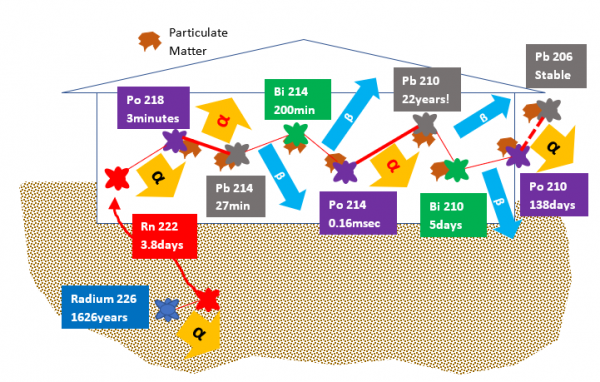
Radioactive decay of radon is only the first step, and unfortunately, not the most significant step in radon’s path to stability. Radon is first converted into polonium (218Po), an unstable, solid isotope that has a half-life of only 3 minutes before it emits another alpha particle and decays to lead (214Pb). The polonium atom is electrostatically attracted to particulates in the air, which have a greater chance of being deposited on cell tissue deep within the lungs before its conversion to lead.
Current US EPA guidelines recommend keeping indoor radon levels below 4pCi/liter. One pCi represents 2.2 radon decays per minute, so 4pCi/liter level indicates 8.8 radon decays in a liter volume per minute. At normal activity levels, we breathe about 8 liters per minute undergoing 70 alpha particle emissions. Most inhaled radon, fortunately, is exhaled (RE Thompson, Johns Hopkins Bloomberg School of Public Health, “Radon”, Encyclopedia of Toxicology, Vol 4, 2014).
Radon’s alpha particle emissions within our lungs may not be so destructive because as a “noble gas” its solubility is low, keeping radon largely restricted to respiration air where its alpha particle emission must pass through gas and mucosol layers before reaching cellular tissue.
The 70 polonium (218Po) atoms formed are very soluble, such that radon decaying to polonium within our lungs is likely to be absorbed in alveoli and respiratory bronchioles. Polonium formed externally in room air is electrostatically attracted to airborne particulates, providing another chance for the polonium atoms to be inhaled and deposited adjacent to tissue for its next decay step.
Airborne polonium (218Po), which only has a few minutes before decaying, may not make it back into our lungs before decaying into a form of lead (214Pb). Lead atoms also cling to airborne particulates for 30 minutes or so, giving it more time for inhalation and deposition before radioactively converting into bismuth (214Bi). Bismuth, likewise, will continue to cling to airborne particulates for another 3 to 4 hours, providing plenty more time to be inhaled by a building’s occupants. When the bismuth decays, it briefly (fraction of a second) turns into another form of polonium (214Po), followed by a couple decade long existence as another radioactive form of lead (210Pb).
The first polonium (218Po) atom formed from radon is an alpha particle decay emitter, which if occurring adjacent to soft tissue is destructive. The next two steps are “beta decays” of the lead (214Pb) into bismuth (214Bi) with a half-life of 28 minutes, followed by beta decay of bismuth (214Bi) with a 20 minute half-life into another form of polonium (214Po). The beta decays are not so destructive within our bodies because they are spread over a longer distance (0.5cm) rather than an alpha particle’s energy deposition occurring within distance thinner than a hair.
Polonium (214Po) formed by bismuths decay has a half life of 164 microsconds with another destructive alpha particle decay that converts polonium into yet another radioactive form of lead (210Pb). At this point, we have had three alpha particle emissions from one radon atom as it moves toward atomic stability.
Electrostatic attraction of these intermediate decay products to a room’s airborne particulates are very concerning because of their tendency to deposit throughout the respiratory system where alpha particle decays can take place adjacent to cellular tissues. We also note that small (submicron) particulates with attached radioactive elements can move into the blood stream from the lungs with more than enough time to reach other tissue, organs and bones before additional decay steps occur.
Rip Van Winkle Decay
Lead (210Pb) does a Rip Van Winkle imitation with its 22-year half-life. It seems relatively dormant, but it is not. Lead migrates throughout our bodies, with much of it depositing in our bones as well as scattered about in our heart, organs, and brain. Children with growing bones can tuck away greater amounts of radioactive lead. Bone deterioration in older adults releases radioactive lead back into our body. As previously mentioned, radon progeny formed in the brain is trapped in the brain by blood-for the rest of our lives.
More studies are needed to understand the pathways and fate of lead (210Pb) within our bodies, however, what is certain is that any lead (210Pb) in our bodies will continuously decay over many decades. Lead (210Pb) emits a beta particle as it converts to bismuth (210Bi), with a brief 5 day half life, followed by another beta emission and conversion of bismuth (210Bi) to another radioactive form of polonium (210Po).
This insidious form of polonium (210Po) is known as the substance used to poison ex-Russian spy Alexander Litvinenko, resulting in his painful, torturous death. Polonium (210Po) poisoning is very difficult to detect because alpha particle emissions are wholly absorbed within human tissue. Likewise, although at much lower dosages, potential health impacts associated with polonium (210Po) decay in our bodies are difficult to assess.
Finally, polonium’s (210Po) 138-day half-life ends radon’s journey as it emits another destructive alpha particle while converting to a stable form of lead (206Pb). Although this lead is not radioactive, it is lead, a substance to have no safe concentration level in humans.
Controlling Radon
A radon measurement is a snapshot of a complex balance of the flow of radon into a home, its decay, and outflow of radon from a home. As with other pollutants, one of the most effective ways to manage radon is dilution with fresh filtered outdoor air. Infiltration that depends on wind is unreliable for managing radon. Radon varies hour-by-hour and day-by-day. Radon varies with climatic conditions (eg, wind driven infiltration), barometric pressure, soil condition (wet versus dry soil), and local geology. It’s complex, but don’t be discouraged, you can control it!
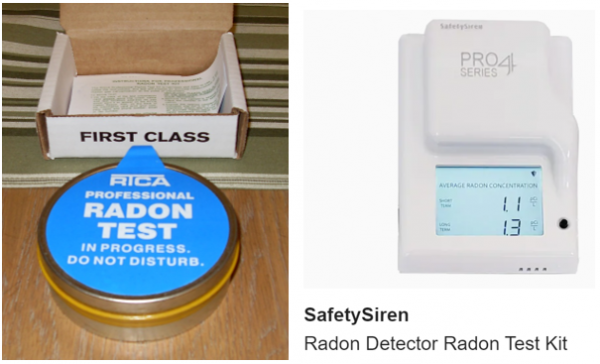
Radon test kits and sensors are available for radon measurement (see photos). We recommend the electronic sensors ($250 to $300) because you can watch variations of radon over time and track the impact of changes made to your home. Daily readings (3 day moving average) from an electronic radon sensor are shown in the attached plot for Equinox House during its first six months of occupancy. Periodic readings since that time consistently measure less than 2pCi/liter.
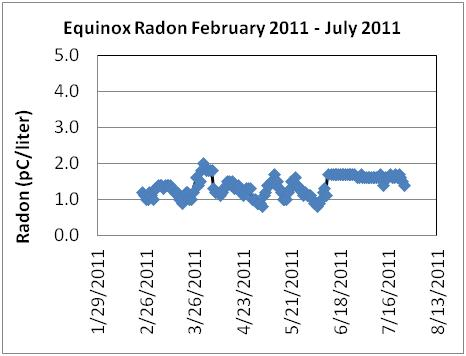
Measuring radon is important for determining your current situation, and for predicting the impact of changes to your home’s construction and operation. For example, sealing a home to lower infiltration will increase radon while increasing fresh air ventilation will reduce radon levels. But by how much? Sealing foundation cracks and other penetrations in your foundation should reduce radon levels, however the amount of reduction must be evaluated relative to changes in house infiltration and ventilation air flows.
Maintaining slightly positive indoor air pressure relative to outdoor atmospheric pressure helps reduce radon flow into a home, too. Although this pressure imbalance may seem undesirable, the difference in air flow due to the pressure difference is small in nicely sealed homes and not noticeable in your utility bill.
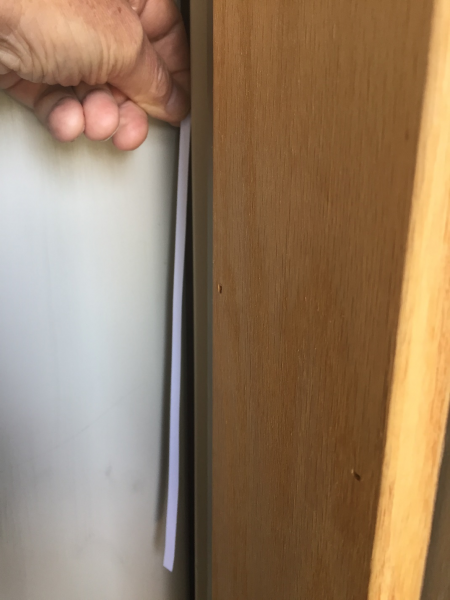
A simple test for checking indoor to outdoor pressure difference is to cut a thin strip of paper (~1/4” wide by 8-10” long) or a length of thread or lightweight strong about 12” long. Open an exterior door to the outside about ¼” or so, and hold the paper strip or thread in the opening to see which way it blows. If it blows into the house, the house is negatively pressured, and if it tries to blow to the outside, it is positively pressured. If the air pressure difference pushes the door open or pulls it closed, the differential pressure is fairly substantial. Make fan adjustments (easy to do with the CERV2, but should not be needed with good duct design) until no door movement by positive pressure difference is observed (see photo).
“Pressure” readings with the strip of paper or thread are quite sensitive. You may even find that the top of a doorway is positive (air blowing outside) while the bottom of the door opening is negative (air blowing indoors). Upstairs and downstairs may also be differently pressured relative to outdoors due to air density variations.
Source reduction, as with other pollutants, is always important. For radon, that means sealing the foundation! Sump pits, expansion joints, wall-to-floor foundation seams, holes for water supply and sewer pipelines, and any other place where soil gas can move into your home. By sealing these paths, you are impeding the flow of radon into your home, forcing it to find other paths into the atmosphere.
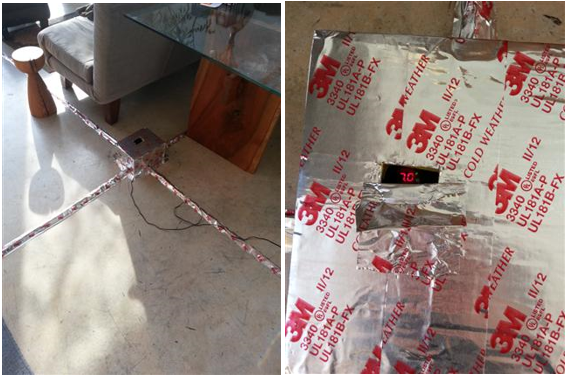
The photo above shows a concrete floor with unsealed expansion joints. The home had radon levels exceeding 4pCi per liter. We placed two radon sensors in the living area with the concrete floor. One sensor was mounted in an upside-down box (open to the floor) located above the intersection of two expansion joints (saw cuts) in the concrete floor.
Electronic radon sensors require an initiation period that time averages readings over a multi-day period. For our sensors, readings begin on the 3rd day of sensor operation and are an average of the past 3 days. We started both sensors several days before the experiment to check that both sensors were in agreement. On November 12 (2012…yes, we have been doing this for quite a while!), aluminum tape “tunnels” were placed over the floor expansion joints. The aluminum tape tunnels were pinched closed at the outer four ends. The tape tunnels were sealed to the upside-down box with enclosed radon sensor. An aluminum tape flap covering the sensor reading window was briefly lifted for daily readings, and re-sealed after the reading to keep radon mostly contained in the tunnel-collector box.
The attached plot shows how radon concentration in the room decreased because the tunnels restricted radon flow into the room. Radon in the box increased as radon flowed into the box from the tunnels. Both room and box radon readings were identical initially. The readings begin diverging day after day as room radon decreased while box radon increased. After the experiment, all exposed expansion joints were sealed with caulk. In combination with balanced ventilation, radon levels were reduced to 2pCi per liter.
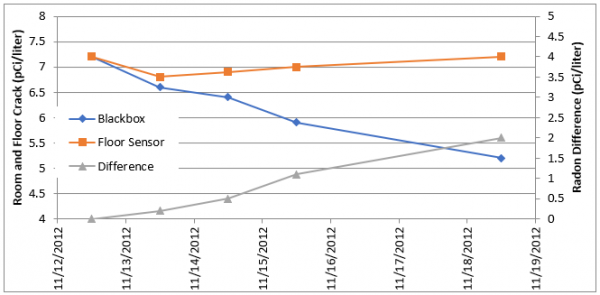
Sealing and improving ventilation may not be sufficient in some cases for reducing radon to a desired level. Although ventilation could continue to be increased to reduce radon, once fresh air ventilation is sufficient to maintain our recommended 800ppm of carbon dioxide concentration, other remedies should be explored for additional radon reduction.
In such cases, more aggressive action, such as under-slab depressurization, can divert and exhaust radon before it enters a home. Under-slab depressurization involves cutting a hole through the ground connected floor, and installing a fan to reduce air pressure in the ground under the floor to below atmospheric pressure. The small airflow with soil gases pulled from the hole is exhausted outside.
Radon raters and radon remediators are generally state licensed professionals. In some states, a radon measurement company cannot also be a remediation company, although you may find a radon rating company and a remediation company owned by the same entity. Regulations for measuring and remediating radon vary widely by state. Sometimes a state’s nuclear authority manages their radon program, while in others it may be their department of public health. It is confusing, and penalties for not following a particular state’s regulations can be severe.
Ventilation Impact on Radon
Build Equinox has conducted extensive research into radon characteristics of buildings and how ventilation impacts radon levels. We present two case studies from field research conducted 10 years ago prior to the first generation CERV’s market release. Our mission to improve health and well-being in indoor environments means understanding every facet of indoor environments, from comfort conditioning to moisture management to energy usage. We know from our research that exceptional indoor environments can be efficiently created in all buildings. The result will be reduction and reversal of today’s unhealthy buildings that continuously degrade of our health!
Case 1
Case 1 is a home with an average occupancy of 2 and a fairly high infiltration and ventilation air flow. The solid red data points for the CO2 and VOC concentration plot are the average readings taken at 5-minute intervals over a week of monitoring. Our dynamic air quality analysis algorithms determine average ventilation and infiltration air flow to be 63cfm (this is like a blower door analysis, but without lugging and setting up a blower door!).
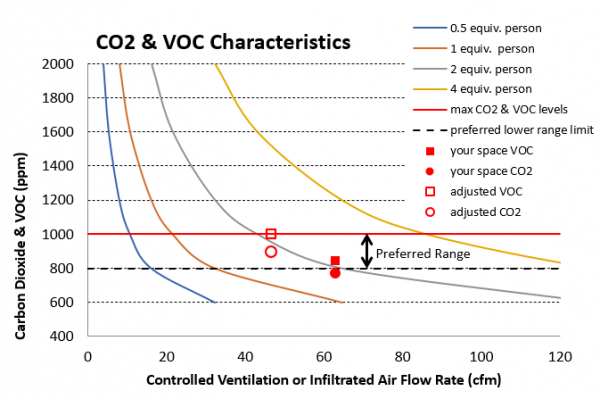
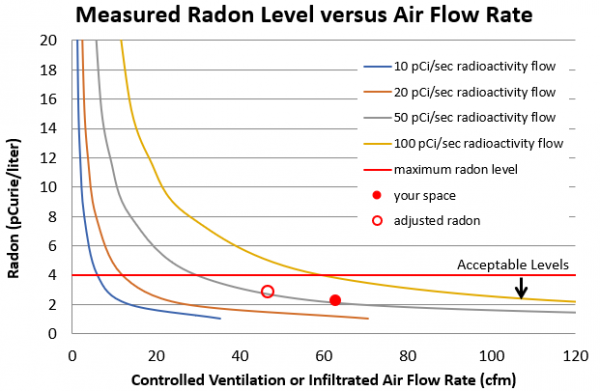
The accompanying radon characteristics plot for Case 1 shows an average radon reading of 2.2pCi/liter. A unique feature of our analyses shown on the plot are lines of “radioactivity flow rate” into the home. Radioactivity flow rate?….what is that? The flow rate of radioactivity is a very important characteristic of a home, telling us how the home’s radon level will change as the home’s infiltration and ventilation levels change. Even though Case 1 home’s radon concentration is good, 50pCi per second of radioactivity flowing into the home is high, and efforts to better seal its foundation would be beneficial.
For example, supposed the Case 1 home’s occupancy stays the same, but an adjustment is made that reduces home’s ventilation and infiltration air flow from 63cfm (determined from our analysis algorithms) to 47cfm, an amount that would increase CO2 and equivalent VOC concentration to 1000ppm. We can see that radon would increase from 2.2pCi/liter (measured) to a predicted 2.9pCi/liter. If the home’s average occupancy dropped to 1 person rather than 2 people, ventilation could be reduced to 20 to 25cfm while maintaining 1000ppm carbon dioxide concentration. Radon, however, would increase along the 50pCi/second line to a radon level of 5pCi/liter.
We note that this home has a good balance of CO2 and VOCs. Reducing the home’s radioactivity flow to 20pCi/second or less, would keep radon below 4pCi/liter over a much broader range of ventilation air flow.
Case 2
Case 2 is the opposite of Case 1 in that it is well sealed with no active ventilation and poor air quality. The home has two working occupants, resulting in a “fractional” occupancy characteristic. Even though occupancy is relatively low, average CO2 levels are higher than desired (the home also has gas cooking, a significant source of CO2). VOCs are low relative to CO2 levels, which is often characteristic of gas cooking. CO2 production by one stove top burner is more than respiration output of 5 occupants.
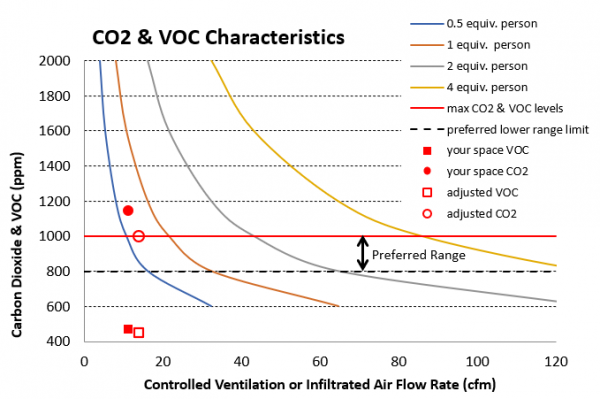
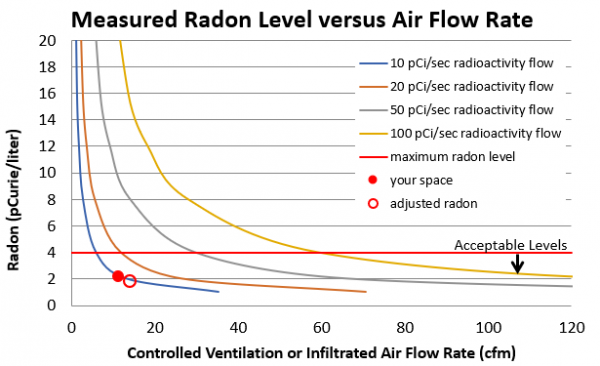
6 months prior to our IAQ monitoring, the Case 2 homeowner measured radon levels greater than 20pCi/liter. The homeowner installed a radon remediation system (underflow soil depressurization as previously described). Our monitoring study demonstrated that the remediation was very effective, lowering radon in the basement to 2.2pCi/liter. Radioactivity flow into the home was reduced to 10pCi/second. Any increase in fresh air ventilation, sorely needed to reduce CO2 in the Case 2 home, will reduce radon even lower.
We would like to tell you that the Case 2 homeowner (a friend of ours) has now installed a fresh air ventilation system and converted their home to all-electric usage, but unfortunately that’s not the case. For some, reducing energy takes a disproportioned position in building priorities. A radon level above 20pCi/liter was shocking enough to spark action for its remediation, but the seemingly invisible long term health degradation caused by poor IAQ and airborne particulates is difficult for some to see.
Whole House Air Recirculation Filtration and Radon
Recirculation and filtration will remove some of radon’s progeny attached to indoor particulates. Too many homes are being designed on a false premise that a constant ventilation air flow with no recirculation is a healthy home. A home without recirculation is not a healthy home. A home without recirculation wastes fresh air delivered to unoccupied rooms. A home without recirculation often has poor air quality in occupied rooms. A home without recirculation has higher particulate densities. A home without recirculation has higher airborne microbe (virus and bacteria) concentrations. And a home without recirculation has higher radioactive particulate densities. Read our reports on smart ventilation and smart air distribution to learn more.
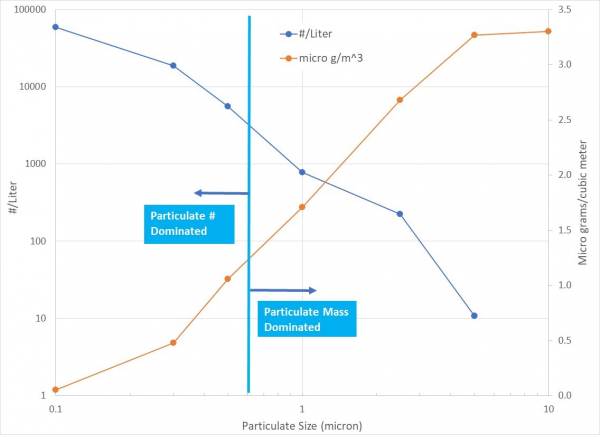
A level of recirculation, somewhere in the range of 20 to 40cfm per person of air recirculation through a MERV13 filter or better, is essential in all homes! Most particulates are generated indoors in today’s sealed, high-performance homes. Not only are particulates bad by themselves, they attract microbes and radon’s progeny to further add to particulate’s already bad characteristics. A figure from our recent news article (“Filters are More Important than Energy”), shows particulate mass density and particulate counts in Equinox House using Piera Systems Canaree sensor. Equinox House particulate levels are low (PM10 less than 3.5µg/m3) in comparison to today’s 12µg/m3 standard.
PM (Particulate Mass) is a poor parameter for determining radon progeny’s potential impact. Even though particulate mass is very low, we note that Equinox House’s particulate count (PC) is 10,000’s of particulates in every liter of air! Piera Systems sensor is the first, non-laboratory grade sensor capable of 0.1 to 10 micron particulate counting. We note that cooking events and smoking/vaping can easily move a home’s interior to a million particulates per liter!
This sea of small particulates swirling about us in most indoor environments do not contribute much mass (37,000 submicron particulates 0.3micron in diameter have the same mass as a single 10micron particulate!). These particulates do provide radon’s radioactive progeny (polonium, lead and bismuth) with many more times the number of aerial assault vehicles needed to transport the radioactive atoms deep into our lungs where they can be deposited next to lung tissue. Some of the radioactive particulates will decay in our lungs, while others have enough time to be transported across cellular walls into the bloodstream where they can travel to many other organs and tissue.
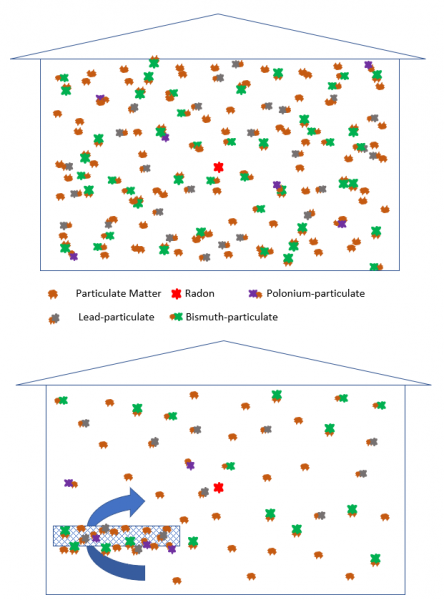
A final schematic shows how recirculation and filtration lowers radioactive particulate density along with overall particulate density. The top schematic shows a home without filtration and the lower home schematic shows the impact of filtration. Radon is shown unattached to any airborne particulates while radon progeny are attached to particulates. Filters do not remove radon because its electrically neutral atoms are not attracted to larger, filterable particulates. Much of radon’s potential damage, as previously discussed, is caused by its progeny that are electrically charged solids strongly attracted to airborne particulates.
This figure shows that relative to a single radon atom entering a home, there are many more progeny in the air. The larger number of progeny atoms is due to the unending march of radon atom’s conversion to other atoms. If one radon atom (red atom in the figure) enters the home and immediately decays every minute, a polonium atom (purple atom) is formed, and roughly remains a polonium atom for 3 minutes as additional radon atoms enter and decay into polonium. Even more lead (gray atoms) begin to stack up with it 27 minute half-life, followed by even more bismuth (green atoms) with a 200 minute half-life.
Although bismuth’s (214Bi) beta decay is not as concerning to our health as an alpha decay, bismuth provides a relatively stable platform for delivering it into our lungs, followed by a rapid polonium alpha decay to another form of lead.
The lower figure shows roughly a 75% reduction of particulate density from the top figure due to air recirculation and filtering. Absolute particulate count, whether 10,000 or 100,000 per liter, is not important in terms of radioactive particulate reduction. The relative decrease of particulate count due to filtered recirculation is the important factor. That is, a 50% reduction of particulates, either a drop from 100,000 (without filtration) to 50,000 (filtration), or a drop from 10,000 (without filtration) to 5000 (filtration) is the important factor because radioactive particulate numbers will be reduced roughly in proportion to overall particulate reduction.
For many reasons cited, recirculation filtering of building air is essential. Once through, constant ventilation based on today’s poor ventilation standards is not sufficient for effective particulate management, resulting in multiple indoor air quality problems and accumulation potential health problems over a building occupant’s lifetime.
Summary
Controlling radon is very important, however, radon represents a complex series of steps in contrast to simple pollutants such as carbon dioxide. Radon and its progeny have multiple paths with multiple health implications that occur over several decades. Radon has the unique capability of being transported across the blood-brain barrier where its progeny become brain-locked and potentially cause neurological problems decades later. Radon’s progeny have multiple pathways to other regions of the body, including bones, organs and tissue.
Minimizing radon and progeny concentrations require fresh air ventilation (dilution) and recirculation filtration. Source reduction at joints and openings adjacent to soil is important to restrict radon’s flow into buildings. Positive pressure in buildings further inhibits radon’s flow into a building.
Measuring building radon levels, coupled with monitoring other IAQ parameters (CO2, VOCs, particulate mass and particulate count) provide an important reference for determining how changes to a building and its operation impact variations in radon concentration. The flow of radon radioactivity into a building is an important characteristic. For homes, reducing radioactivity flow below 20pCi per second helps keep radon below 4 pCi per liter as building occupancy, infiltration and ventilation levels are varied.
Finally, while radon is a pollutant with long term health concerns that require continued research to better define, no guesswork is required for the management of radon and its progeny.























